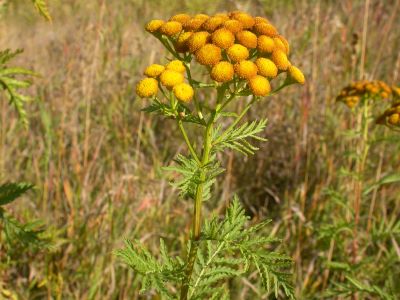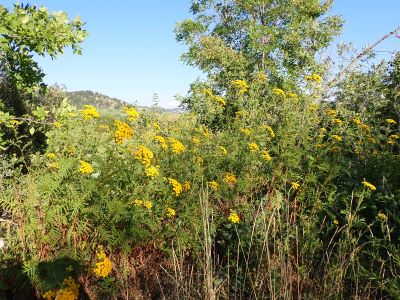Common tansy (Tanacetum vulgare)
By Noelle Orloff, Associate Extension Specialist and Schutter Lab Diagnostician
Introduction

Photo; Matt Lavin, MSU
Common tansy is an exotic perennial forb in the Asteraceae family that is on Montana’s noxious weed list. It inhabits higher moisture, disturbed soils, and can be found in places like meadows and riparian areas as well as along roadsides, ditches, and railroad tracks. Common tansy was introduced to North America from Europe for medicinal use and as an ornamental plant.
Identification
When common tansy is flowering it is relatively easy to recognize. Flowering heads resemble yellow buttons, and are arranged in flat-topped, compact clusters. Leaves are alternately arranged and pinnately compound. They appear “feathery,” with leaf segments having sharply lobed and toothed edges. Stems tend to be somewhat reddish in color. Common tansy has aromatic foliage, and it also has white sap. This species often grows around three or four feet tall.
Biology, Ecology, and Impacts

Photo; Matt Lavin, MSU
Common tansy is a perennial species that reproduces mainly by seeds, but it also spreads by creeping rhizomes that allow it to form dense patches. Dense stands decrease forage availability for grazing animals. This species is considered toxic to both livestock and humans if enough is consumed. Common tansy contains thujone, a toxin that can cause miscarriages, convulsions, stomach pain, and skin irritation. In large enough quantities it has been reported to cause abortion in cattle and is also suspected to affect goats and horses. It is relatively unpalatable, and for this reason cases of livestock poisoning are rare.
Management
Common tansy management is best undertaken with an integrated approach. For mechanical control, mowing is not generally thought to be effective in controlling established plants, but mowing just before flowering may decrease seed production. Handpulling may be useful in very small, newly established patches, but make sure to wear gloves and long sleeves. The most effective herbicides for controlling common tansy are those containing metsulfuron (e.g., Escort® and Chaparral™). Herbicides containing 2,4-D or glyphosate can be somewhat effective, with the best results occurring with a wiper type application. Make sure to read all label instructions for these herbicides before use. Finally, encouraging a stand of competitive vegetation and limiting disturbance can help slow the spread of this species and limit its encroachment into new areas.
See the MSU Extension publication Common tansy (Tanacetum vulgare) for more details about common tansy and its management.
Further Information
For more information about this month's weed post, contact Noelle Orloff. Past posts are available in the Monthly Weed Post Directory.
This weed post is also available as a printable PDF (458 KB).
